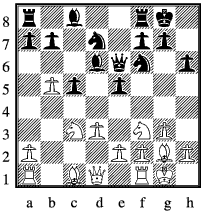
December 2012
A week before the event we had a dozen entries and rumours of other potential pairings. However a couple of withdrawals and no firming up of the rumours left us with a field of 10 pairs. Momentarily this was 9½ as Robert Taylor arrived sans team mate due to illness. However after a couple of abortive phone calls in an attempt to find him a partner, I stepped in to offer my services, reckoning that there was little chance that controlling the event would be so hectic as to make this unwise. Indeed this proved a correct call; I was not needed once in my official capacity during play, whilst a field of ten with no colours to worry about hardly taxed my pairing skills between rounds.
A mid-morning start led to lunch after two two rounds and a five o'clock finish. Several of us took advantage of the excellent chippie in Holmes Chapel for refuelling. This certainly seemed to boost the Newcastle team of alan Paling and Pete Shaw whose lunchtime score of ½/4 was boosted by a perfect 6/6 in the afternoon to finish level with George and Ben Scattergood and just a ½ point behind winners Mike Hancock and Ian Chester. The mixed club pairing of Robert Taylor and RR took almost the opposite route, racing clear afyter 3 rounds with a score before collapsing to a final tally of 6 for fourth place. RR blames himself for letting good positions in his final two games go to rot, but in truth nearly everyone will have had tales of what should have been.
With the withdrawals leaving only three entries in the 220 section this had to be merged with the bigger boys. Each of these three teams played each other and three teams from the 320s, so the winning score of 4½/10 by Dave Price and Paul clifford was particularly commendable, with Richard Martin and Oliver Horrocks scoring 2½ in coming second in the section.
Thanks are due to Sandra and Jon Blackburn for handling the Victoria Club end and for providing free tea, coffee and biscuits.
Was the event a success? How does one define success? We had more than the equivalent of a county teams worth of participants, which given the difficulty of raising such teams is hardly a failure. There was not a broad base of support, with only just over half the Association's clubs represented, there being no players from Stafford, Meir, Kidsgrove or Cheddleton. However with five pairs from Holmes Chapel and one from Macclesfield there seems justification for taking an event into Cheshire. Ultimately the test is whether the players enjoyed themselves or were simply turnimg out of a sense of duty. It is unlikely they'll tell me if they think it was a waste of time, so keep your ears to the ground.
comment on this article
Division 1
|
Division 2
|
Division two also suffered its first postponement of the season with Newcastle B asking Cheddleton C not to visit, leaving both teams 100% records intact for a little longer.
Division 3
|
Division 4
|
Plenty of matches, but no postponements in division 4 also. However here the outcome is that the teams are becoming more spread, with Meir B appearing the team most likely to challenge the Cheddleton-Fenton duopoly.
Cup action has seen Cheddleton and Holmes Chapel reaching the major final, each enjoying 3 - 2 victories over Newcastle and Alsager respectively. Holmes Chapel and Stafford join Cheddleton and Newcastle in the semi-finals of the Intermediate Cup having overcome Alsager and Fenton respectively. Cheddleton complete the semi-final line-up in the Perry Trophy on the back of a narrow win over Alsager.
Just one defaulted board in the league to report, Alsager B being a man short for their visit to Newcastle D in division 3.
The first of the Strong players GP events attracted a field of six, with Robert Shaw scoring 4/5 to top a hard fought all-play-all.
comment on this article
Those who have followed this year's third division will know that Ian Jamieson plays top board for Kidsgrove, so this is not a step down in the standard of opposition I might have expected tonight. I first met Ian en route to a Crewe congress several years ago, and came across him on several occasions in southern congresses before he moved up here and initially joined Newcastle before transferring to Kidsgrove. However I don't recall ever playing him in a 'proper' game. I doubt that the game stays in anyones book for long, so giving it in its entirety won't give away any trade secrets.
1 b4 e5, 2 b5 c5, 3 c4 d5, 4 cxd5 Qxd5 Strange. Given RR's penchant for certain lines in the Scandinavian he might have been expected to play Nf6, which would save him worrying about the placement of his queen over the next few moves.
5 Nc3 Qe6, 6 g3 Nd7, 7 Bg2 Ngf6, 8 Nf3 h6 Not a move I like playing, and in truth unnecessary here, but I'd like my queen to be able to rest awhile.
9 d3 Bd6 Liked the look of c4 here, but decided that this smelt too much of starting operations before my king was safely castled.
10 O-O O-O

|
| Ian Jamieson v RR after 10 ... 0-0 |
11 Nd2 Nb6, 12 a4 Nbd5, 13 Nxd5 Nxd5, 14 Nc4 Bd7 Keen to get the bishop into the game and temporarily hold back further advance of the white queenside pawns, though a rook move probably superior.
15 Ne3 Nxe3 16 Bxe3 This exchange of knights is to my liking, not because I want knights off but because I'd far rather his bishop be placed on e3 than b2.
16 ... Rab8, 17 Qc2 b6, 18 Qc4 Qxc4, 19 dxc4 Be6
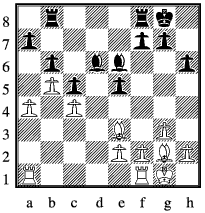
|
| Ian Jamieson v RR after 19 ... Be6 |
20 Rac1 Ian is not on form.
20 Rfd1 Rbd8, 21 Bd5 at least threatens to leave him with the better bishop, and temporarily at maintains for now the chances of usefully opening the a-file.
20 ... Bc7, 21 a5 Rfd8, 22 axb6 axb6, 23 f3 f5 Probably should have grabbed the a-file whilst I could. But it turns out that there is also time for that later as Ian continues his attempt to rearrange his pieces to improve his c-pawn's survival chances.
24 Bf2 Rd2, 25 Rfe1 Ra8, 26 Bf1 Raa2, 27 Rc3 f4 Keen on cramping the white dark squared bishop, but better to relocate my own f6 or 5 via d8. Neither of us are covering ourselves in glory - RR misplaying his attack and Ian his defence.
28 g4 g5 But RR is not seriously threatening the g-pawn so Rec1 and Be1 looks a better plan.
29 Rec1 Kf7, 30 h3 Ke7 King up for the endgame. A sure sign that RR doesn't see that he needs to blast the position open with e4
31 Be1 Rd8, 32 e3 e4 RR wakes up. Fortunately the move is still available - what if Ian had played e4 himself?
33 fxe4 fxe3, 34 R3c2 Rxc2, 35 Rxc2 Rd1 0-1
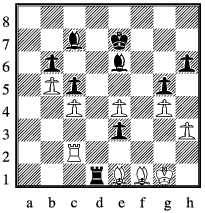
|
| Ian Jamieson v RR final position |
Never did discover what sort of double bishop ending it would be.
comment on this article
1 Nf3 f5, 2 c4 d6 Are we out of your book yet?
3 d4 e6, 4 b4 Be7, 5 e3 Nf6, 6 Nbd2 c5 More than any other move this one is responsible for setting the shape of this game. a5 may have been more natural, but it doesn't have the same effect on the centre. This shove against the line of pawns on b4, c4, d4 is not that uncommon (to those who get such a line of pawns!) and may be played even in positions in which the move doesn't have the backing of the bishop so offers a pawn. White is rarely well advised to accept the offer as his resulting doubled isolated c-pawns are liable to undermine his initial material advantage.
7 bxc5 dxc5, 8 Nb3 O-O, 9 Bd3 cxd4, 10 exd4 Perhaps Simon would have been better maintaining central tension with b6, but this exchange sets up the main question: Are whites hanging pawns weaker or stronger than black's backward e-pawn?
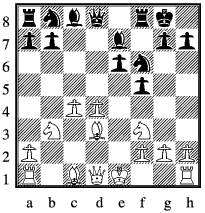
|
| RR v Simon Edwards after 10 exd4 |
16 ... Bb7 with threat of Nxd4 threatening the queen, and discovering a mate threat against g2.
17 f4 quickly puts a stop to that Qf6
18 Be2 Ne7, 19 Bf3 Bxf3, 20 Rxf3 Rac8
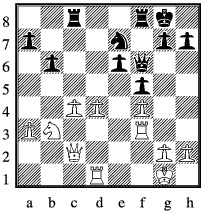
|
| RR v Simon Edwards after 20 ... Rac8 |
21 Qe2 Rfd8, 22 Re3 Ng6, 23 g3 Nf8, 24 Re5 Qe7
Moving hanging pawns is a big commitment as they no longer control the squares in front of them. However I'm not fond of the idea of passively defending the a-pawn and moving it allows Qb4, which doesn't seem sensible. An exchange of material with
25 Rxf5 Qxa3, 26 Rb5 Rd7 has attractions - his e-pawn is now isolated. Against this however are possible problems that could then be posed by his a-pawn.
25 c5 Kf7 protection for the queen, but now
26 d5 bxc5, 27 dxe6+ Kg8, 28 Rxd8 Rxd8, 29 Nxc5 and RR emerges a pawn up.
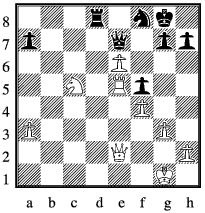
|
| RR v Simon Edwards after 29 Nxc5 |
30 Qc4 g6, 31 Qb4 Rc6, 32 Qc4 Nxe6 Simon offers a draw, and it is easy to see why. I guess there is the slenderest smidgeon of a chance he'll go wrong, so I'll play one more move:
33 Rxe6 Qxc5+ He doesn't play Rxc5 (and I wasn't hoping for that as a means to pick up his a-pawn - I was thinking mate). ½-½
comment on this article